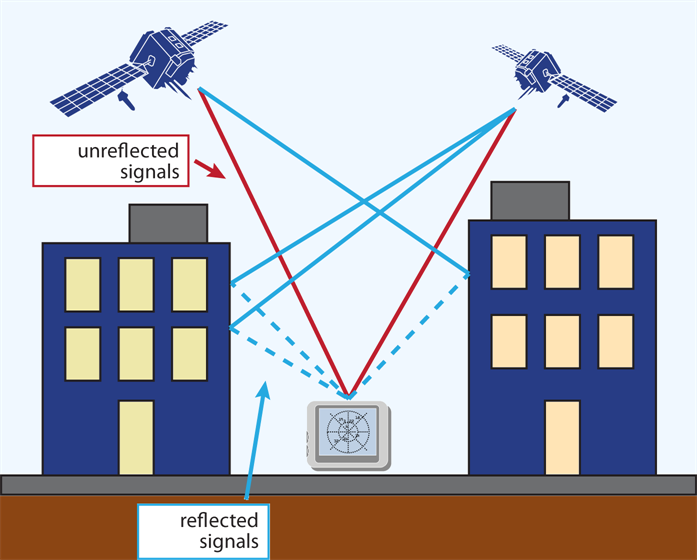Multipath Signals
A multipath signal is a GNSS signal bouncing off a reflective surface prior to reaching the GNSS receiver antenna. Quite likely, this causes many of the same signals to arrive at the receiver at different times. The receiver then needs to determine which of the signals are received directly.

Multipath signals in urban environment
To configure a multipath signal, navigate to Select > Select Scenario > Configure Scenario, View 2/3: Advanced, and specify a number greater than zero for Multipath signals.
Note: Your GSG unit requires free channel(s) available, in order to allow for the creation and configuration of a (several) new multipath signal(s).
Press enter to display the first configuration view for the first Multipath signal (the number of views equals the number of signals you specified.)

Multipath signal configuration view
The following multipath parameters are configurable:
Satellite
- This specifies which satellite is to be duplicated by the multipath signal. The value specified is a running number starting from 1 to the number of satellites defined to be in the scenario. ‘1’ would mean that we will duplicate the satellite in the first position when scenario starts.
Range
- Offset: The Range (or: Code) offset in meters. For a multipath signal this value should typically be positive, meaning that the travelled distance of the signal will be longer than that of the original or line-of-sight (LOS) signal.
- Change: Change in range offset, given in meters / Interval
- Interval: Specify change interval in seconds to the nearest tenth second.
Doppler
- Offset: The offset in Doppler in centimeters/seconds
- Change: Change in Doppler offset, given in centimeters/seconds/Interval
- Interval: Specifying change interval in seconds.
The code (range offset) and Doppler are connected 1-to-1 and cannot be controlled separately in a conflicting manner. For example, a Range Change of 0.019 m/s with Interval ‘1’ has the same effect as specifying Doppler to 1.9 cm/s and leaving all Change/Interval settings at 0.
When both code, and range, and possible change/intervals are specified, the cumulative effect of all things specified will be simulated.
To simulate, e.g., a carrier phase offset that is static relative the LOS signal, please specify the code offset (to, e.g., 0.095 meter) at start and set all Code and Doppler settings to zero.
Random CP
The carrier phase offset can also be randomized on startup by setting the ‘Multipath random CP” to ‘On’ in the GSG menu (or ‘RandomMpCP’ keyword in the configuration file).
Power
- Offset: The offset in output Power in dB
- Change: Change in Power offset, given in dB / Interval
- Interval: Specifying change interval in seconds. If the interval is zero, the offsets will be set at startup and remain static.
Considerations:
- SBAS and interference/jamming channels cannot be duplicated.
- The Change/Interval effect will be interpolated. If the initial interval is zero, the offsets will be set at startup and remain static.
- In a multi-frequency constellation, the multipath configuration will apply to all active bands.
- To match the multipath conditions as specified in the LTE/3GPPS A-GNSS test specification, for GPS the following settings should be used:
- Range Offset 150 m
- Doppler Offset 1.9 cm/s
- Power Offset -6dB
- Multipath random CP: ON.
Press the view key to configure the next multipath signal, when several multipath signals are configured.
Press the exit key to save your multipath configuration.